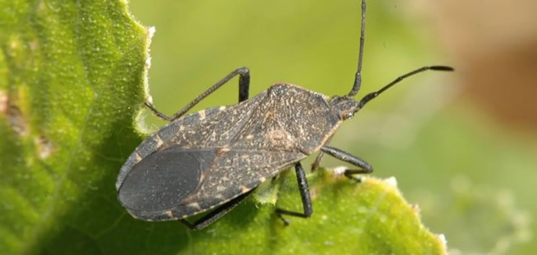
Squash Bug (Coreidae): known as leaf footed bugs for their enlarged hind legs. Squash bugs are major pests that migrate from squash to other nearby plants. They are sucking insects which are harmful to all plants since a large community can drain plants of nutrients. They are found in communities of adults and nymphs living together.
- Life Cycle: eggs are laid in clusters on squash and pumpkin leaves and stems. After hatching, nymphs stay in groups and suck the nutrients from plants. Adults stay on plants near the young bugs to feed.
- Behavior: will attempt to bite. Squash bugs will rest on the floor under plants and hide under leaves to remain hidden.
- Food Source: squash, pumpkins, sunflowers
- Management: general insecticide application, especially during egg laying.
- Pests in Gardens and Landscapes: Squash Bugs.
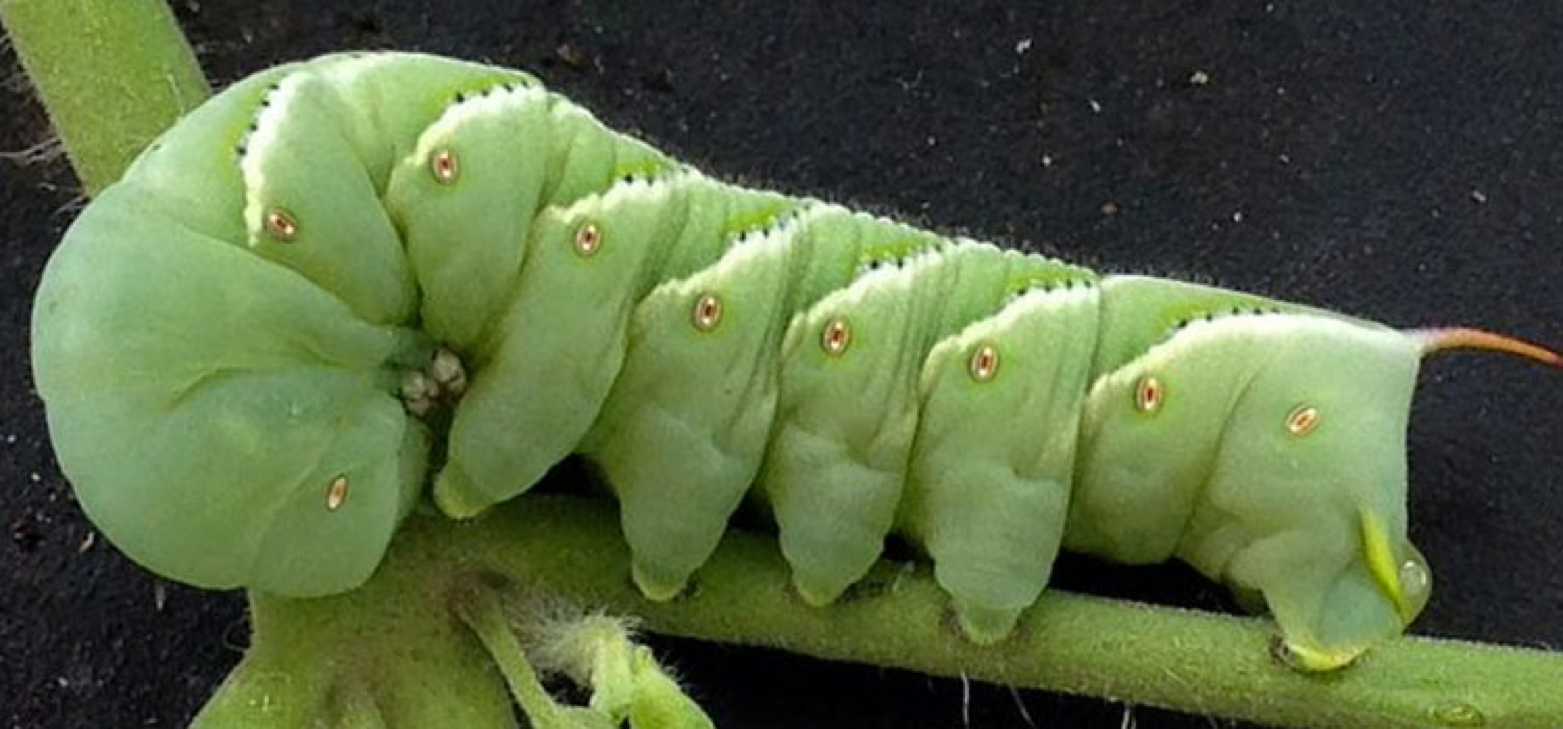
Tomato Hornworm (Sphingidae): larvae are highly voracious and destructive tomato pests. These emerald green caterpillars grow in size quickly and completely defoliate young tomato plants, and consume enough leaves on large plants to cause wilting. The caterpillars primarily ingest leaves and stems, but also harm tomato fruits, making them additionally undesirable since the fruits cannot be sold or used.
- Life Cycle: during spring and summer, overwintering adult moths lay eggs in clusters on tomato leaf undersides. Larvae hatch and immediately attack tomato leaves. There are 4 to 5 instars. Larvae drop to the ground to pupate and adults hatch in the fall before overwintering.
- Behavior: caterpillars are semi-aggressive and may attempt to bite when handled. They are usually found on the stems and branches of tomato plants.
- Food Source: tomato family plants including eggplant and potato
- Management: release parasitoid wasps (Braconidae, Sphecidae, Ichneumonidae) which use these caterpillars as a food source for their many eggs. Set up pheromone traps to keep adults from reproducing. Use pesticides sparingly since tomatoes host beneficial wildlife.
- Tomato Hornworms.
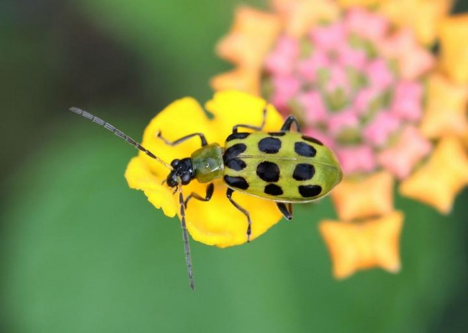
Cucumber Beetle (Chrysomelidae): as a member of the leaf beetle family, cucumber beetles spend much of their time on the underside of vegetable leaves. A chewing pest of cucurbits, they can be found in large numbers during late spring and summer. They can be mistaken for lady beetles due to their green and spotted or striped wings. The larvae are corn pests. They can spread fecal bacteria to the plants known as bacterial wilt.
- Life Cycle: after overwintering in weedy fields, adults move to gardens and farms when plants begin to emerge. They lay eggs in the soil or at the base of the plant. After hatching, larvae feed on corn roots for a few weeks before pupating then emerging as adults which feed on plants above ground.
- Behavior: beetles are attracted to feeding stimulants released by their host plants near the buds and new leaves. This results in a bigger infestation. Adults also attack cucumber fruits.
- Food Source: corn roots as larvae, cucumbers and similar plants as adults, including sweet potato. Adults will eat flower heads.
- Management: soldier beetles, some parasitoid flies and wasps, insect pathogens, trap crops, insecticides that modify behavior, feeding hormones (to attract the beetles to weeds or non-host plants).
- Cucumber Beetles
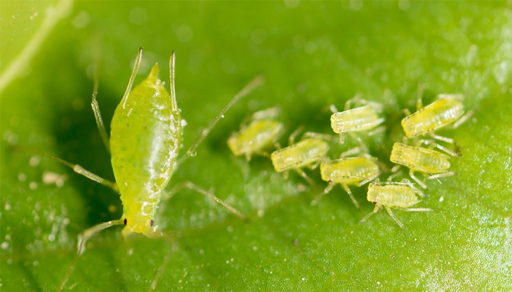
Aphids (Aphididae): semi-social sucking pests of many flowers, shrubs and trees. They drain plants of their nutrients, and prevent beneficial insects from using plants as a food source. They are used as “livestock” by ants, including fire ants, which also are pests.
- Life Cycle: adult females lay eggs near the colony on branches/stems and leaves in spring and summer. Eggs hatch into nymphs which grow as they feed and live with the adults. Nymphs are smaller copies of adult aphids. They eventually molt and grow into adults, with females gaining wings and mating.
- Behavior: live in colonies. They allow ants to tend to them, providing their waste in the form of honeydew, a sweet secretion which ants use as food.
- Food Source: plant juices and nutrients. They feed on a wide variety of crops, flowering plants and trees, including fruit and nut trees. There are aphids that primarily attack pecans and cause leaf discoloration.
- Management: lady beetles are available for purchase, and both the larvae and adults will eradicate aphid populations in agricultural and garden settings. Insecticide soaps, and acidic pesticides are effective methods.
- Aphids.
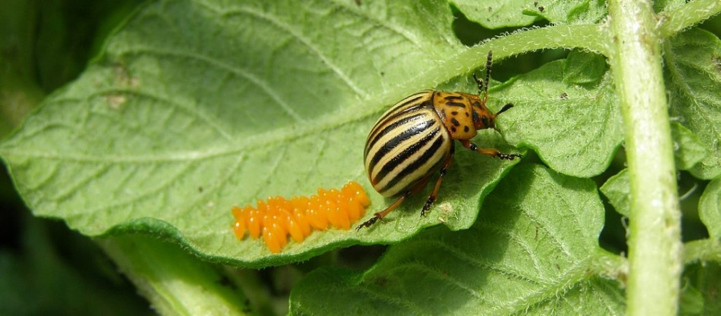
Colorado Potato Beetle (Chrysomelidae): insect pests in the leaf beetle family. Adult beetles are golden yellow with white and black striped wings. They are dome-shaped and feed on potato leaves, but will migrate to plants that are related to potatoes, including tomatoes and eggplants.
- Life Cycle: after overwintering underground in fields and gardens, adults appear when potato plants emerge (Spring), laying their egg masses under leaves. When the larvae hatch after 2 weeks, they are humpbacked and dark red with black heads and spots on their sides. They feed on the leaves all over the plant, defoliating plants completely as they grow in size. Fully grown larvae are bright red or salmon pink. Larvae take about 10 days to complete development if temperatures are I the 80’s during their feeding. The final instar larvae burrow into the soil to pupate, before hatching into adults. Fall adults will overwinter.
- Behavior: semi-social insects that stay clustered, but disperse as they feed.
- Food Source: potatoes, tomatoes, eggplants, nightshade.
- Management: remove weeds in the nightshade family that serve as hosts for larvae to weaken the population. Grow varieties of potato plants that mature quickly to mitigate the damage caused when beetles feed on young plants. Alternate crops with a plant on which the Potato Beetles do not feed. Incorporate their natural enemies including stinkbugs and lady beetles.
- Colorado Potato Beetles.
